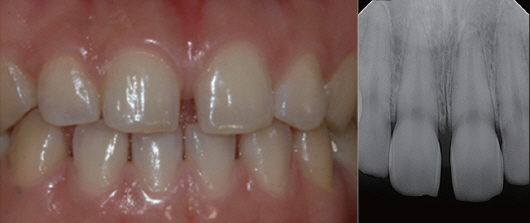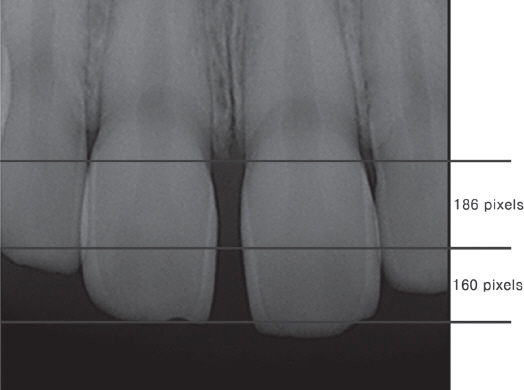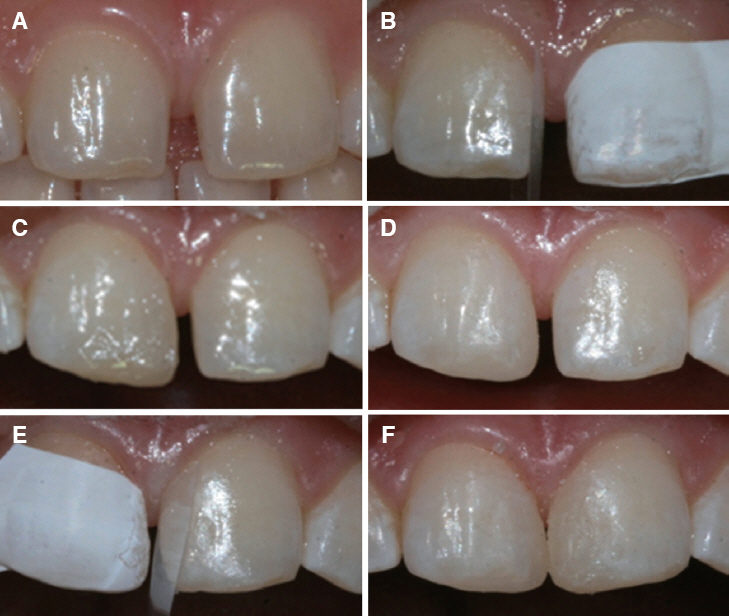J Dent Rehabil Appl Sci.
2017 Jun;33(2):163-168. 10.14368/jdras.2017.33.2.163.
Conservative and esthetic closure of maxillary midline diastema without creating "black triangle" using direct resin composite
- Affiliations
-
- 1Dental Clinic Center, Pusan National University Hospital, Busan, Republic of Korea.
- 2Department of Conservative Dentistry, School of Dentistry, Pusan National University, Yangsan, Republic of Korea. jeongkil@pusan.ac.kr
- KMID: 2388023
- DOI: http://doi.org/10.14368/jdras.2017.33.2.163
Abstract
- Anterior diastemas are common esthetic problems. One of the challenges in clinical esthetic dentistry is closing anterior diastemas without creating "black triangles" between the teeth. The success of a restorative treatment in anterior teeth depends on the esthetic integration between soft tissues and hard tissues. This report describes the successfully accomplished diastema closure case by producing the emergence profile with natural contours at the gingival-tooth interface and then generating of gingival recontouring process.
Keyword
Figure
Reference
-
References
1. Keene HJ. Distribution of diastemas in the dentition of man. Am J Phys Anthropol. 1963; 21:437–41. DOI: 10.1002/ajpa.1330210402.2. Kaimenyi JT. Occurrence of midline diastema and frenum attachments amongst school children in Nairobi, Kenya. Indian J Dent Res. 1998; 9:67–71.3. Tanaka OM, Morino AY, Machuca OF, Schneider NÁ. When the midline diastema is not characteristic of the “ugly duckling” stage. Case Rep Dent. 2015; 2015:924743. doi:10.1155/2015/9247433. [Epub 2015 Aug 5].4. Kavanagh C, Kavanagh D. Maxillary midline diastemaaetiology and orthodontic treatment. J Ir Dent Assoc. 2004; 50:22–8.5. Mattos CT, da Silva DL, Ruellas AC. Relapse of a maxillary median diastema:closure and permanent retention. Am J Orthod Dentofacial Orthop. 2012; 141:e23–7. DOI: 10.1016/j.ajodo.2011.05.022. PMID: 22196198.6. De Araujo EM Jr, Fortkamp S, Baratieri LN. Closure of diastema and gingival recontouring using direct adhesive restorations:a case report. J Esthet Restor Dent. 2009; 21:229–40. DOI: 10.1111/j.1708-8240.2009.00267.x. PMID: 19689720.7. Magne P, Belser U. Bonded porcelain restorations in the anterior dentition:a biomimetic approach. 1st ed. Chicago: Quintessence Books;2003. p. 1405.8. Miranda ME, Olivieri KA, Rigolin FJ, Basting RT. Ceramic fragments and metal-free full crowns:a conservative esthetic option for closing diastemas and rehabilitating smiles. Oper Dent. 2013; 38:56771. DOI: 10.2341/12-225-T. PMID: 23570298.9. Blatz MB, Hürzeler MB, Strub JR. Reconstruction of the lost interproximal papilla-presentation of surgical and nonsurgical approaches. Int J Periodontics Restorative Dent. 1999; 19:395–406.10. Helvey GA. Closing diastemas and creating artificial gingiva with polymer ceramics. Compend Contin Educ Dent. 2002; 23:983–98.11. Kim YH, Cho YB. Diastema closure with direct composite:architectural gingival contouring. J Korean Acad Conserv Dent. 2011; 36:515–20. DOI: 10.5395/JKACD.2011.36.6.515.12. Magne P, Belser UC. Porcelain versus composite inlays/onlays:effects of mechanical loads on stress distribution, adhesion, and crown flexure. Int J Periodontics Restorative Dent. 2003; 23:543–55.13. Berksun S, Kedici PS, Saglam S. Repair of fractured porcelain restorations with composite bonded porcelain laminate contours. J Prosthet Dent. 1993; 69:457–8. DOI: 10.1016/0022-3913(93)90151-D.14. Korkut B, Yanikoglu F, Tagtekin D. Direct midline diastema closure with composite layering technique:a one-year follow-up. Case Rep Dent. 2016; 2016:6810984. doi:10.1155/2016/6810984. [Epub 2016 Jan 6]. DOI: 10.1155/2016/6810984.15. Croll BM. Emergence profiles in natural tooth contour. Part II:clinical considerations. J Prosthet Dent. 1990; 63:374–9. DOI: 10.1016/0022-3913(90)90223-Y.16. Kois JC. The restorative-periodontal interface:biological parameters. Periodontol. 2000; 1996; 11:29–38. DOI: 10.1111/j.1600-0757.1996.tb00180.x. PMID: 9567954.17. Singh VP, Uppoor AS, Nayak DG, Shah D. Black triangle dilemma and its management in esthetic dentistry. Dent Res J (Isfahan). 2013; 10:296–301.18. Takei HH. The interdental space. Dent Clin North Am. 1980; 24:169–76.19. Tarnow DP, Magner AW, Fletcher P. The effect of the distance from the contact point to the crest of bone on the presence or absence of the interproximal dental papilla. J Periodontol. 1992; 63:995–6. DOI: 10.1902/jop.1992.63.12.995. PMID: 1474471.
- Full Text Links
- Actions
-
Cited
- CITED
-
- Close
- Share
- Similar articles
-
- Diastema closure using direct bonding restorations combined with orthodontic treatment: a case report
- Diastema closure with direct composite: architectural gingival contouring
- The effect of the amount of interdental spacing on the stress distribution in maxillary central incisors restored with porcelain laminate veneer and composite resin: A 3D-finite element analysis
- Clinical study on the relapse of diastema
- Development of anticariogenic composite resin





